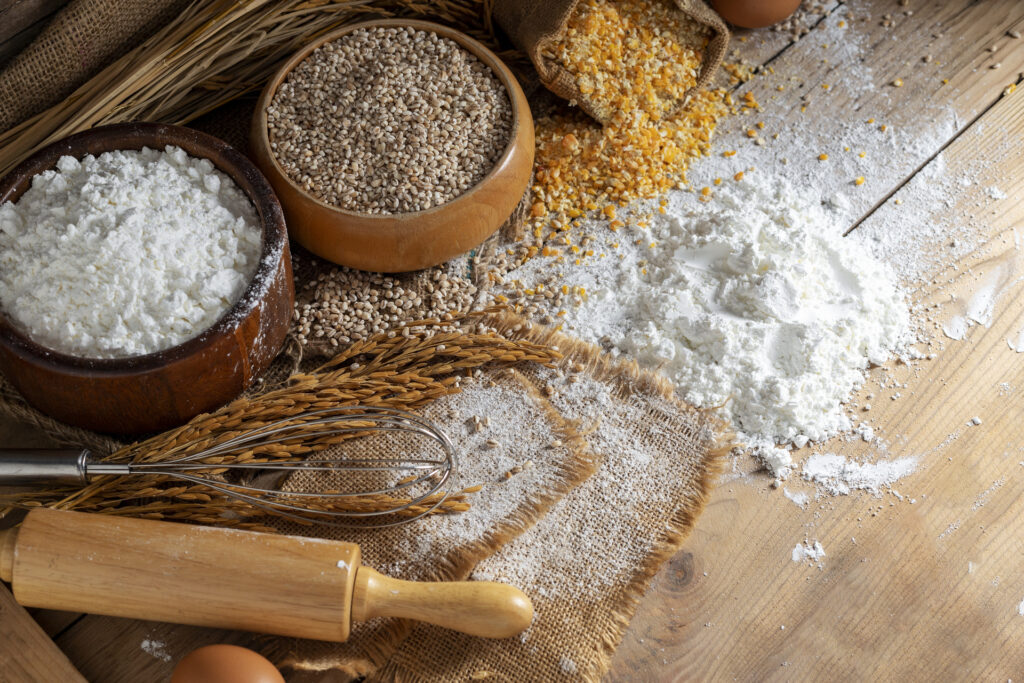
Flour is a staple ingredient in kitchens worldwide, forming the foundation of countless recipes, from bread and pastries to pasta and desserts. However, not all flours are created equal. Each type has unique properties, making choosing the right one for your culinary creations essential. Join Chef Abdul as he explores the fascinating world of flour, helping you make informed choices to elevate your cooking and baking.
All-purpose flour is a kitchen staple that lives up to its name. A moderate protein content (10-12%) balances gluten strength and tenderness, making it ideal for cookies, cakes, and flatbreads.
Chef Abdul’s Tip: Sift all-purpose flour to remove lumps and aerate the mixture for softer results.
Whole wheat flour is made by milling the wheat kernel and retaining the bran, germ, and endosperm. This flour is rich in fibre, vitamins, and minerals, perfect for creating wholesome bread, chapatis, and muffins.
Chef Abdul’s Tip: When substituting whole wheat flour for white flour, use 50% initially to balance flavour and texture.
Derived from durum wheat, semolina flour is coarser and higher in protein. It’s the key to authentic pasta, gnocchi, and Middle Eastern desserts like basbousa.
Chef Abdul’s Tip: Pair semolina with a drizzle of olive oil and warm spices to enhance the flavour in savoury dishes.
Rice flour is gluten-free and made from finely milled white or brown rice. It’s a staple in Asian cuisines, used in recipes like rice cakes, noodles, and tempura batter.
Chef Abdul’s Tip: Mix rice flour with a pinch of turmeric and chilli powder before frying vegetables or seafood for a crispy coating.
Chickpea flour, also known as gram or besan, is made from ground chickpeas. Its nutty flavour and high protein content make it ideal for savoury pancakes, falafel, and Indian pakoras.
Chef Abdul’s Tip: Add a pinch of cumin and coriander to the chickpea flour batter for an aromatic twist.
Coconut flour from dried coconut meat is a favourite in low-carb and gluten-free baking. Its high fibre absorbs moisture, so recipes often require extra eggs or liquid.
Chef Abdul’s Tip: Use coconut flour for pancakes or energy bars, pairing it with natural sweeteners like honey or dates.
Spelt flour is a whole grain flour with a slightly nutty flavour. It’s lighter than traditional whole wheat flour, making it a popular choice for breads and pastries.
Chef Abdul’s Tip: Avoid over-mixing spelt flour dough to maintain its delicate texture.
Oat flour is made by grinding oats into a fine powder. It’s rich in soluble fibre, which helps manage cholesterol and makes baked goods tender.
Chef Abdul’s Tip: Combine oat flour with almond flour for a delicious gluten-free crumble topping.
Self-rising flour is all-purpose flour pre-mixed with baking powder and salt. It’s perfect for quick breads, biscuits, and pancakes.
Chef Abdul’s Tip: Always check the freshness of self-rising flour; stale baking powder may affect the rise of your baked goods.
Almond flour is a gluten-free option made from finely ground almonds. Its mild, nutty flavour makes it excellent for cookies, cakes, and savoury crusts.
Chef Abdul’s Tip: For an extra crunch, toast almond flour slightly before using it in recipes.
Choosing the Right Flour: Chef Abdul’s Recommendations
Understanding the unique properties of different types of flour can transform your culinary creations. Chef Abdul says, “The secret to great cooking lies in knowing your ingredients and treating them carefully.” Experiment with these flours in your kitchen, and let your imagination guide you to new culinary heights.
Chef Abdul © Copyright 2024. All rights reserved.